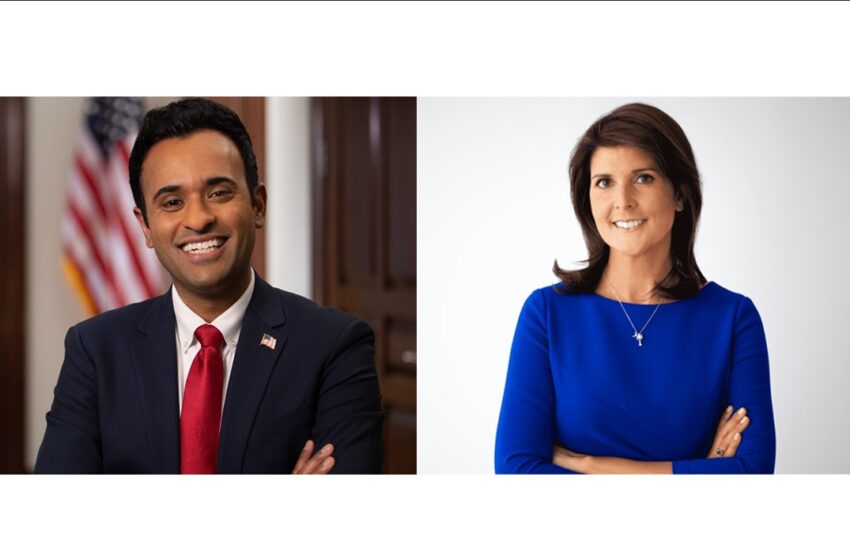Four Indian Americans are running for president. Could anyone have imagined two decades ago?

Two standout performers during the inaugural Republican presidential debate at Fiserv Forum in Milwaukee, Wisconsin, last week were former South Carolina Governor Nikki Haley and the 38-year-old Ohio entrepreneur Vivek Ramaswamy.
Both are second-generation Indian Americans who traveled their distinct pathways to get to the U.S. Haley, following a traditional political trajectory, has served as a state legislator, governor, and U.S. ambassador to the United Nations. In contrast, Ramaswamy is an Ivy League-educated political neophyte, who built a billion-dollar biopharma business and authored a bestselling book.
In addition to Haley and Ramaswamy, two other Indian Americans are also seeking the GOP nomination: New Jersey entrepreneur Hirsh Vardhan Singh and MIT Ph.D. Shiva Ayyadurai, both veterans of several state and national campaigns.
Since 2017, Singh has run for the U.S. House of Representatives and the U.S. Senate, as well as for the New Jersey governor. Ayyadurai, an activist who has campaigned against genetically modified food and COVID-19 vaccines, ran for the U.S. Senate in 2018 and 2020.
Although Singh and Ayyadurai are considered fringe candidates, their presence in the race for the highest office in the land adds additional evidence to the growing importance of Indian Americans in America’s political landscape.
READ: Indian American community rockets its way to relevance (September 4, 2020)
A couple of decades ago, it would have been difficult to imagine that an Indian American would be vying for the nomination of a major party for the President of the United States.
It is particularly noteworthy considering that the four above-mentioned candidates are vying for the nomination of the Republican Party. Opinion polls have consistently revealed that approximately two-thirds of Indian American voters tend to identify with and cast their votes for Democratic Party candidates in presidential elections.
On the Democratic side, the bench is even stronger. As is well known, the current Vice President of the United States is Kamala Harris, the daughter of an Indian immigrant mother and a Jamaican father.
The trailblazing candidacy of Harris — who, as the saying goes, is a heartbeat away from the presidency — was one of the uplifting stories of the 2020 elections.
At this juncture, the current vice president is almost certain to be the running mate of President Joe Biden, who has announced his intention to seek re-election next year.
Harris will be one of the dozens of Democrats on the ballot in the current election cycle. Others include five incumbent members of U.S. Congress: Representatives Ami Bera, Ro Khanna, Pramila Jayapal, Raja Krishnamoorthi, and Shri Thanedar.
According to Indian American Impact, a nonprofit that focuses on building Indian American political power, only five Indian Americans were elected to public office in the country in the first 226 years of the nation’s existence.
Last year, there were more than 176 Indian American elected officials, holding various positions at federal, state and local levels, ranging from the office of the vice president to city council memberships across the nation.
READ: Vivek Ramaswamy embraces American nationalist identity for 2024 race (June 7, 2023)
The trend is likely to continue next year, as scores of Indian Americans from diverse backgrounds have come forward to run for office. They include elected officials aspiring for higher offices. Notably, New York State Senator Kevin Thomas is vying for a seat in the U.S. House of Representatives from the state’s 4th Congressional District. Amish Shah, a current member of the Arizona House of Representatives, is a candidate for the U.S. House of Representatives in the state’s 1st Congressional District. Both are Democrats.
Then there are political novices, such as Republicans Rejani Raveendran, a 40-year-old college student and single mother of three, who is running for the U.S. Senate from Wisconsin, and Chennai-born physician Dr. Prasanth Reddy, a candidate for 3rd Congressional District of Kansas.
Many of these candidates are unlikely to gain much traction, but their efforts should be applauded. As the late British physicist Stephen Hawking said, “Showing up is half the battle.”
Equally important, they will motivate more members of the community to run for office and engage in public service.
There’s no doubt that the significant success of the Indian American community stands as one of the remarkable narratives in American politics over the past decade.
It is especially striking when seen in contrast with the larger political trend — the rise of nativist rightwing ideologies, symbolized by the “Make America Great Again” (MAGA) movement led by former President Donald Trump.
READ: Record number of Indian American candidates on ballot across the country (October 9, 2020)
In fact, the ascendancy of Indian Americans and other minority groups, among other factors, may have contributed to the surge of Trump’s brand of politics, which has at its core the politics of grievance.
Ironically, that has not prevented many Indian American Republicans from gravitating toward the former president, who is at this stage the overwhelming favorite to win the GOP nomination.
Some of the Indian American candidates are actually running on the coattails of Trump. None more so than Ramaswamy, who seems to operate with the former president’s playbook and has succeeded in capturing the imagination of Trump’s base.
READ: Politically, 2016 is a ‘Miracle Year’ for Indian Americans (December 31, 2016)
Nonetheless, the progress achieved by the Indian American community serves as an example for all minority groups in the United States. Amid broader political shifts, the achievements and impact of Indian Americans — who comprise less than one percent of the American electorate numerically — stand as a testament to the nation’s diversity and its potential for positive change.
